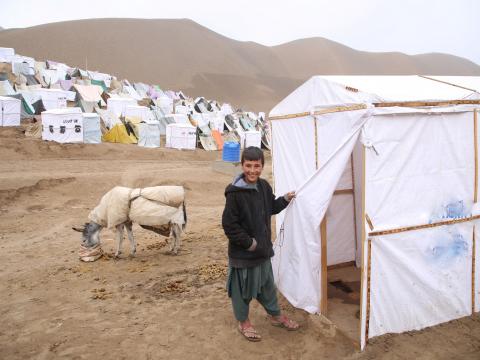Combined latrine/bathing for Internally Displaced Families

Hasina, 12, sits with her mother and siblings around a circular stone, cracking pistachios with a small hammer. At some point nature calls and Hasina takes some tissue from the corner of the family tent and heads the three metres to a small, white, rectangular shelter that serves as a toilet.
Since Hasina’s family fled their home village six months ago due to drought, they have lacked access to proper bathroom facilities. Up until now, these kinds of luxuries in Internally Displaced Peoples (IDP) camps have been a far-flung wish.
With no toilets in IDP areas, open defecation was common practice. People used fields, bushes, and other public spaces to meet their needs. The scenario was even worse for women who routinely had to wait for the cover of night after all of the men and young boys had gone into their tents. Sometimes encounters with stray dogs forced them to walk even farther afield to find a safe place.
Hawagul, Hasina’s mother, places a pistachio on the round stone. “We went up to the mountains,” she says, pointing to a hill a fair distance away. It was like this every time the women had to go the bathroom; a constant search for a private, secluded place away from the business of the camp. She adds that women usually went in pairs, with one of them keeping watch in case anyone approached.
Open defecation only added to existing challenges in the IDP camp such as lack of food, clean water and poor sanitation. The smell constantly lingered, attracting flies and other insects and vermin.
Nor did the family have any place to bathe. They hadn’t used a washroom for weeks and going to a public bathroom in the city meant they had to spend extra money. “Back home,” Hawagul says, “we went to bathe two times a week, but here it is so difficult.” She wasn’t even able to wash during or after her menstrual cycle since there wasn’t a proper place. “If it was really necessary, we took everything out of the tent and bathed inside.”
According to recent site visits by OCHA and UNICEF to IDP settlements in Qala e Naw city, the capital of Badghis Province, camps lack an adequate number of latrines and bathing areas. In response, World Vision has partnered with UNICEF to provide 440 combined latrine/bathing structures which will meet the needs of 8,880 people including 1097 boys and 1073 girls in five IDP sites.
As she finishes recalling those especially difficult first months, Hawagul collects all of the shelled pistachios and puts them in a plastic bag. She says the family is grateful for all that World Vision has done. “God bless you. You saved our lives. Whenever I need to go to a toilet I can go easily on my own. I can also take my children to a proper bathroom when they feel the need.”
The struggles of the internally displaced in Afghanistan are far from over, with a lack of food and the onset of miserable winter cold. That said, the dignity of being able to access proper latrines in the camps has restored a little bit of optimism that aid agencies have not forgotten about those who have been forced into camps by extreme drought.
